If you must communicate by spitting like you say, spit on the faces of the tens thousands of coup plotters throughout Turkish history, traitors in the Turkish army. FETO wasn't the first won't be the last that turned the weapons and power trusted to them against the goverment and the nation. They are still inside Turkish Armed Forces today.
You are using an out of date browser. It may not display this or other websites correctly.
You should upgrade or use an alternative browser.
You should upgrade or use an alternative browser.
B-1B is not nuclear capable anymore. Only about half of B-2s and small number of B-52s are.Timing and public announcement of nuclear capable bombers is no coincidence.
The name of the 10th Tanker Base Command located in Incirlik/Adana has been changed to “10th Main Jet Base Command” in line with the needs of our Air Force.
18 April-10 May 2024 Al Dhafra Air Base/United Arab Emirates
3 F-16 aircraft and 53 personnel from our 181st Fleet Command are participating in the Desert Flag-9/2024 Exercise.
3 F-16 aircraft and 53 personnel from our 181st Fleet Command are participating in the Desert Flag-9/2024 Exercise.
In Germany, FDP is ok with it, SPD is neutral and the Greens are against it.Will Germany approve Türkiye's 40 Eurofighter request? Has attitude of Germans turned to positive?
What did Steinmeier say in Ankara?
Anybody knows?
That woman, the Foreign Minister, Annalena Baerbock, is part of the Greens, and is very against it.
They are trying to convince her.
Germans love shooting themselves in the foot. Could you imagine embargoing a country for using the defence weapons you sold them against their adversaries? Isn't that the point of buying weapons? To use them against your enemy?
Look at this graphic, literally destroying their civil and defense industries to be "morally superior". Then look at France, good for the French.
From 6.3% to 5.6%. And 7.2% to 11%. France is now a bigger exporter of weapons than Russia!
Last edited:
TURKISH TESTERS
- Aviation Features
- Turkish testers
18th October 2018
FEATURE
The demanding flight test requirements of the Turkish Air Force are met by 401 Filo, a specialist unit flying F-4s and F-16s from Eskişehir. Cem Doğut investigates its weapons trials work.
Flight test focus
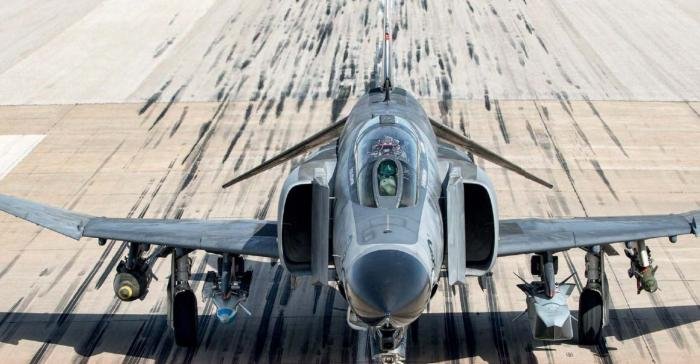
An F-4E 2020 assigned to 111 Filo and carrying (from left to right): HGK, KGK, SOM and LGK-82. The latter is an indigenous version of the 500lb GBU-12 laser-guided bomb.
All photos Cem Doğut
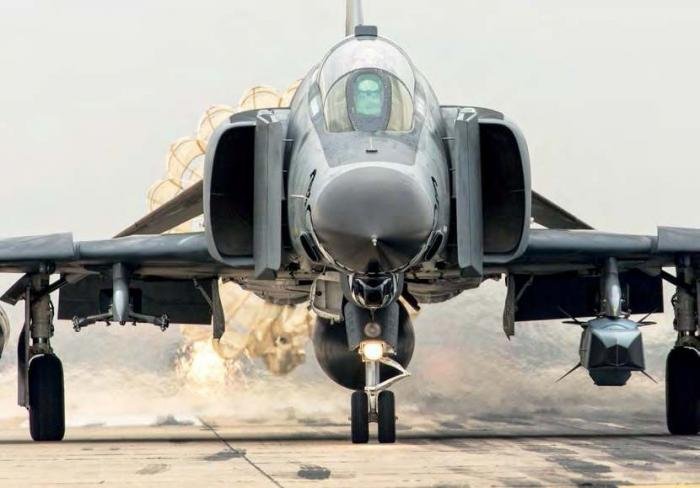
Return to base for a SOMarmed F-4E 2020. This powerful cruise missile weighs around 1,300lb of which the warhead accounts for approximately 500lb.
As one of the final operators of the Phantom, the Türk Hava Kuvvetleri (THK, Turkish Air Force) has embarked on successive programmes to extend the jets’ service life and increase capability. As long ago as August 24, 1995 an agreement was signed with the then Israel Aircraft Industries (IAI) covering structural and avionics work on 54 F-4Es. Of these aircraft, 26 were upgraded at IAI facilities and the rest at the 1. Hava İkmal Bakım Merkezi (1. HİBM, 1st Air Supply Maintenance Centre), in Eskişehir. After modernisation, the Phantom was redesignated as the F-4E 2020 Terminator. The project also established a system integration laboratory and an avionics testing and integration centre at the 1. HİBM. Today, these facilities form the basis of 401 Test Filo – the THK’s dedicated test and evaluation squadron.
In 2004, the 1. HİBM began the Işık (‘light’) programme that provided 18 RF-4Es with a structural and avionics upgrade. Modifications included the installation of an Aselsan LN-100GT integrated inertial navigation system (INS)/GPS, Rockwell Collins CDU- 900Z flight management system, AN/ALQ- 178(V)3 electronic countermeasures system and MXF-484 VHF/UHF radios. The THK’s last RF-4Es were retired in March 2015.

This 401 Test Filo Phantom is carrying an example of the HGK-LAB – a dual-guidance version of the HGK, combining laser and GPS/INS functions.
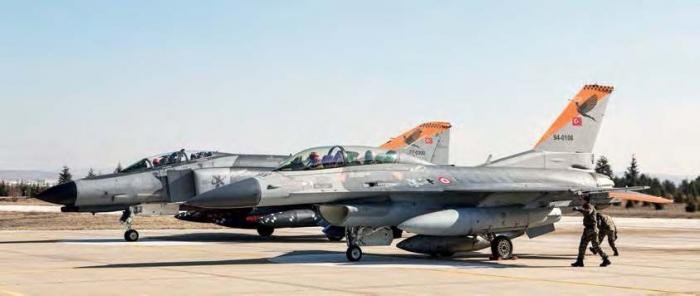
F-16D Block 50 94-0106 and F-4E 2020 77-0300 prepare to depart Eskişehir for a test mission. The Phantom carries examples of the HGK-3, a 500lb version of the HGK and underwing fuel tanks with calibration markings applied, while the ‘Viper’ will serve as a chase aircraft.
The Phantom upgrade projects combined with the Common Configuration Implementation Program (CCIP, pronounced ‘c-sip’) for the F-16C/D, provided the 1. HİBM with valuable avionics testing and integration experience. On April 17, 2013 the 401. Geliştirme Test Kıta Komutanlığı (401st Development Test Battalion Command) was established to ensure that this experience was preserved and built upon.
The THK test squadron, 401 Filo, was established within the Technology and Weapon System Development Command and has operated under the jurisdiction of Eskişehir’s 1st Air Supply Maintenance Centre Command since 1996. On March 13, 2015 it received the title 401 Test Filo Komutanlığı (401 Test Squadron Command). The unit flies F-4E 2020 and F-16C/D aircraft equipped for test work. After the July 15, 2016 coup attempt, 401 Test Filo was reassigned to Eskişehir’s 1. Ana Jet Üssü (1st Main Jet Base).

F-16C Block 40 93-0001 ‘bombed up’ with inert 500lb Mk82s fitted with the Roketsan TEBER modular low-cost guidance kit.
SOM
Among the major projects developed with assistance from the squadron is the Tübitak SAGE SOM (Stand-Off Missile) family of ‘fire and forget’ precision strike weapons, for use against land and sea targets. The SOM uses GPS as its primary mode of guidance complemented by an advanced INS and a radar-based terrain-referenced navigation system, allowing the missile to hug the terrain during flight to evade hostile air defence systems.
According to the manufacturer, the SOM features more advanced aerodynamics and a better configuration than similar missile systems, as well as lightweight composite components to minimise its radar cross-section. A terminal stage infrared (IR) imager detects the individual target by matching its signature with a pre-loaded database of similar targets. The seeker can also be used to provide imagebased mid-course navigation by gathering imagery of waypoints and comparing them against the predicted position to update the navigation system. In this way, if GPS capability is denied or degraded, the missile can follow its waypoints using IR-based terrain updates. The missile includes a twoway datalink to reassign targets in flight.
The SOM cruise missile made a first guided flight over the Black Sea on August 9, 2011. Covering more than 100nm using GPS/ INS guidance, the missile successfully hit its target with a high degree of accuracy. Around 30 test flights were scheduled to assess the SOM and a first batch of missiles had been delivered to the THK by the end of 2011.
The SOM is available in three variants for air force use:
• SOM A: Basic variant designed to engage a military target in simple strike mode using preplanned co-ordinates at the terminal stage
• SOM B1: Advanced variant that engages a military target in precision strike mode using imaging IR matching at the terminal stage
• SOM B2: Special variant with dualstage penetrator warhead to engage strategic and well-protected targets
Precision kits
Tübitak SAGE has also developed the HGK (Hassas Güdüm Kiti, precision guidance kit), a state-of-the-art GPS/INS guidance package that converts an existing 500lb (227kg) Mk82 ‘dumb’ bomb into a ‘smart’ weapon. Integrated GPS/INS guidance allows the HGK to hit a target with a circular error probable (CEP) of less than 20ft (6m) in all weather conditions. An INS-only mode provides the HGK with a CEP of less than 33ft (10m). HGK can reach a range of more than 12nm when released from medium altitude. A maximum range of 15nm is achieved after release from high altitude.
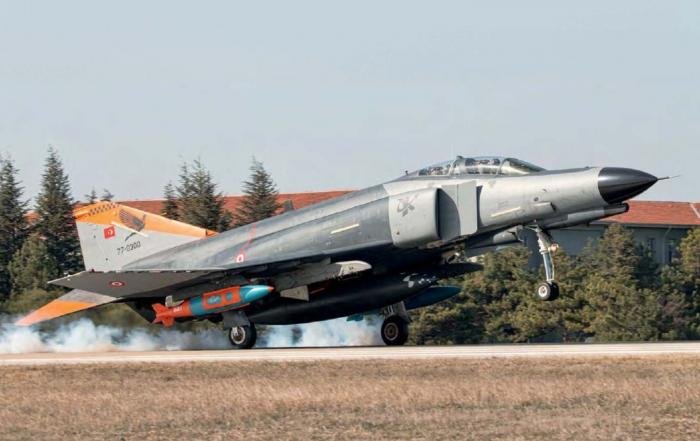
Phantom 77-0300 returns to base carrying an inert HGK test round. In future, Turkey plans to integrate the HGK – and the SOM cruise missile – on the F-35A.
ASELPOD
The Aselsan ASELPOD is another store that has been tested by 401 Test Filo. It weighs 518lb (235kg) and is 7.7ft (2.35m) long. The electro-optical and infrared (EO/IR) sensors can track up to eight targets at a laserdesignation range of a maximum 15.5 miles (25km) and a general range of up to 34 miles (55km). The pod can track moving vehicles such as main battle tanks at 9.3 miles (15km). The pod has a third-generation IR camera with a zoom function and uses a 640x512 pixel detector. The ASELPOD can perform day and night and can be used alongside laser-guided and INS/GPS precision-guided munitions. Development of the ASELPOD is ongoing and includes work on a twoway data link. This will enable the pod to double as an intelligence, surveillance and reconnaissance (ISR) asset in addition to its principal role as a targeting pod.
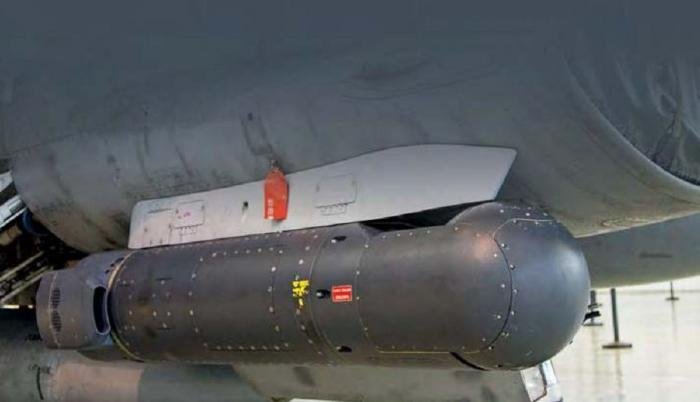
An ASELPOD on an F-16C’s right intake station. The pod is externally almost identical to the Rafael Litening.
The Roketsan TEBER is a modular low-cost guidance kit that can be fitted to 250lb (113kg) Mk81 and 500lb Mk82 general-purpose bombs. It converts the bombs into precision weapons using INS, GPS and an optional laser seeker. The laser seeker provides a capability against moving, relocatable and maritime targets, even if the objective is manoeuvring at high speeds. The CEP is below 10ft (3m) and the weapon has a range of 17 miles (28km).
Penetrating bomb
Tübitak SAGE’s NEB (Nüfuz Edici Bomba, penetrator bomb) is the first concretepenetrator system developed in Turkey and is designed to be used against surface and underground targets.
Penetrating bombs generally use one of two methods for penetration. First are those that provide penetration power using kinetic energy. The BLU-109, for example, has a 1in-thick (2.5cm) steel shell and is detonated by a delayed fuze in the tail. The kinetic energy must be high for the bomb to be effective. The second method makes use of a shaped charge warhead. In contrast, the NEB uses multiple warhead technology: an augmenting charge preceded by a follow-through bomb. It has similar external geometry, guidance unit interfaces, mass, centre of mass and inertia properties as the 2,000lb (907kg) Mk84 generalpurpose bomb, but offers high penetration performance even with low impact velocities and angles. An augmenting charge utilises preformed fragments for high fragmentation effect against surface targets and programmable fuze delay times mean it can be used against various target types. The NEB can be used with all guidance kits compatible with the Mk84 and can be dropped from all aircraft cleared to carry this bomb. Guidance options include the HGK and the GBU-10E/B laser guidance kit.
Wing kit
The Tübitak SAGE KGK (Kanatlı Güdüm Kiti, glide bomb kit) is a wing-assisted guidance kit that converts existing unguided 1,000lb (454kg) Mk83 and 500lb Mk82 generalpurpose bombs into long-range, air-to-ground smart weapons. The KGK employs the same guidance system as the HGK and can hit a target from a range of 62 miles (100km), in all weather conditions, allowing the launch aircraft to attack while avoiding enemy air defences.

Originally published in AirForces Monthly Magazine
In Germany, FDP is ok with it, SPD is neutral and the Greens are against it.
That woman, the Foreign Minister, Annalena Baerbock, is part of the Greens, and is very against it.
They are trying to convince her.
Germans love shooting themselves in the foot. Could you imagine embargoing a country for using the defence weapons you sold them against their adversaries? Isn't that the point of buying weapons? To use them against your enemy?
Look at this graphic, literally destroying their civil and defense industries to be "morally superior". Then look at France, good for the French.
From 6.3% to 5.6%. And 7.2% to 11%. France is now a bigger exporter of weapons than Russia!
View attachment 67691
Germans are taking L upon L.
The German ambassador of the West bank got kicked lmaooo
You had to see I think he was going to do a talk at a university all the Palestinians went up in arms and kicked him out.
Now dont forget how Nicragua has taken them to court.
We can also use Hürküş-2 as CAS in counter-terrorist operations like this, would probably be much more cost efficient than using jets and it might even help pilots.
I don't get the need for Hurkus-2 while we have attack helicopters and UCAVs with different specifications, configurations and low cost munitions. Both our attack helicopter fleet and UCAVs are doing a great job in CAS in all scenarios. They are also stationed close enough or already in the air in the case of the UCAVs where speed is not a big factor. The only factor limiting our low cost CAS is the bad weather conditions, fog.We can also use Hürküş-2 as CAS in counter-terrorist operations like this, would probably be much more cost efficient than using jets and it might even help pilots.
If there is a threat of which the requirements are surpassing the capability of our existing helicopter and UCAV fleet, then the situation desperately needs a fighter jet to be dealt with.
That's my humble opinion.
That's a completely reasonable and effective way of dealing with it as well.I don't get the need for Hurkus-2 while we have attack helicopters and UCAVs with different specifications, configurations and low cost munitions. Both our attack helicopter fleet and UCAVs are doing a great job in CAS in all scenarios. They are also stationed close enough or already in the air in the case of the UCAVs where speed is not a big factor. The only factor limiting our low cost CAS is the bad weather conditions, fog.
If there is a threat of which the requirements are surpassing the capability of our existing helicopter and UCAV fleet, then the situation desperately needs a fighter jet to be dealt with.
That's my humble opinion.
My thinking was a Hürkuş could carry more and heavier munitions than our T-129s and we can blood our pilots before they even start their training in F-16s. Iirc, it can carry 1500kgs which means it can easily carry 6 MK-82s with guidance kits, or maybe even more Tolun's with Sadak 2T which would keep it at a good distance away from any threat (again, only against terrorists, not in an actual war) and they can operate from a longer range and would most definitely be safer than helicopters.
HÜRKÜS C as a converted combat drone yes, but manned I would not send anyone into a conflict or war with turboprop aircraft. These are trainers or third world combat aircraft for their needs, e.g. for patrol and counter-terrorism.We can also use Hürküş-2 as CAS in counter-terrorist operations like this, would probably be much more cost efficient than using jets and it might even help pilots.
Unfortunately, that doesn't work for us - the US supports the YPG/PKK, so we have to assume that they have state-of-the-art MANPADS and other effective equipment that can be used for asymmetric warfare en route.
The only thing that can help is observation with very high-flying HALE drones such as Akinci, Aksungur & Co. and marking the targets for a fighter jet mission or the elimination of these targets by the drone itself outside the radius of action of the MANPADS & Co.
The Hürküs C as a combat drone would make sense if they are stationed in Turkish bases on the Iraqi/Syrian border with temporary runways to fill the gap between an Akinci <- -> F-16, it would be faster to deploy compared to conventional drones and it is also again cheaper than a fighter jet deployment due to its speed & agility, it would also be an ideal complement to the Atak helicopters in support of ground forces.
Last edited:
Mate, when I say close air support I'm not talking about a Vietnam style cas, or even using Cirit or UMTAS; I'm talking about using Tolun or MK-81/82 bombs with guidance kit to hit at targets way out of reach of any manpads, as I mentioned in my post above.HÜRKÜS C as a converted combat drone yes, but manned I would not send anyone into a conflict or war with turboprop aircraft. These are trainers or third world combat aircraft for their needs, e.g. for patrol and counter-terrorism.
Unfortunately, that doesn't work for us - the US supports the YPG/PKK, so we have to assume that they have state-of-the-art MANPADS and other effective equipment that can be used for asymmetric warfare en route.
The only thing that can help is observation with very high-flying HALE drones such as Akinci, Aksungur & Co. and marking the targets for a fighter jet mission or the elimination of these targets by the drone itself outside the radius of action of the MANPADS & Co.
The Hürküs C as a combat drone would make sense if they are stationed in Turkish bases on the Iraqi/Syrian border with temporary runways to fill the gap between an Akinci <- -> F-16, it would be faster to deploy compared to conventional drones and it is also again cheaper than a fighter jet deployment due to its speed & agility, it would also be an ideal complement to the Atak attack helicopters in support of ground forces.
Still wouldn't be opposed to having a more agile drone like that as well though.
You right but regardless of this, it still makes more sense to use the Hürküs C as a drone in future combat scenarios than to fly it manned.Mate, when I say close air support I'm not talking about a Vietnam style cas, or even using Cirit or UMTAS; I'm talking about using Tolun or MK-81/82 bombs with guidance kit to hit at targets way out of reach of any manpads, as I mentioned in my post above.
Still wouldn't be opposed to having a more agile drone like that as well though.
As you know, pilots don't grow on trees - they have years of training and experience in combat missions. Putting these people in a turboprop, regardless of whether they are out of range of the target, to have a risk of attack or not is still negligent. You can replace airplanes and drones, but not pilots, at least not as quickly.
Last edited:
M
But again, this is just an option that is worth considering imo; US, for example, ordered turboprops just a year or two ago to use with their special forces they are not as useless as you make them out to be.
Mate, a turboprop is faster, flies farther up and has more counter measures than our helis and can use heavier munition that is also cheaper. If all you care about is pilots lives, which I also care about which is why I mention long range engagements, then we need to immediately stop using our helis and F4s. I'm also not opposed to it as a drone either, but that would most likely need new design to be optimal.Regardless of this, it still makes more sense Hürküs C as a drone in future combat scenarios than to fly it manned.
As you know, pilots don't grow from trees - they have years of training and experience in combat missions. Putting these people in a turboprop regardless of whether they are out of range of the target to get a risk of attack or not is still negligent. You can't replace airplanes & drones with pilots, at least not as quickly.
But again, this is just an option that is worth considering imo; US, for example, ordered turboprops just a year or two ago to use with their special forces they are not as useless as you make them out to be.
I don't think that the Air Force or the Army will consider armed Hürkus-2 for counter-terrorist operations, maybe the Gendarmerie.I don't get the need for Hurkus-2 while we have attack helicopters and UCAVs with different specifications, configurations and low cost munitions. Both our attack helicopter fleet and UCAVs are doing a great job in CAS in all scenarios. They are also stationed close enough or already in the air in the case of the UCAVs where speed is not a big factor. The only factor limiting our low cost CAS is the bad weather conditions, fog.
If there is a threat of which the requirements are surpassing the capability of our existing helicopter and UCAV fleet, then the situation desperately needs a fighter jet to be dealt with.
That's my humble opinion.
Even for faster low-cost CAS i would prefer Akinci and Kizilelma/Anka3.
If the Police get's Hürkus-C then it wouldn't surprise me when they will demand KAAN in the future too, imagine stealth black painted 5th Gen. fighter with Polis written on, those drug dealers and other criminals should better think twice before doing something stupid.
I see it the same way as you because they could fill the gap between fighter jet missions and drone missions, but I think the conversion in a drone really makes sense and should be feasible without changing the design too much. Where the cockpit is, you could remove everything and only install drone electronics and the SATCOM antennas, there should be enough space.M
Mate, a turboprop is faster, flies farther up and has more counter measures than our helis and can use heavier munition that is also cheaper. If all you care about is pilots lives, which I also care about which is why I mention long range engagements, then we need to immediately stop using our helis and F4s. I'm also not opposed to it as a drone either, but that would most likely need new design to be optimal.
But again, this is just an option that is worth considering imo; US, for example, ordered turboprops just a year or two ago to use with their special forces they are not as useless as you make them out to be.
The USA has also done this, e.g. with the F-16 as the QF-16, without any major design changes.
So guys i am ready to take punches!
I want manned light attack jets that max 2 ton weights and max 9 meter long. Speed is very important.
İt should be made from composite materials. Thanks to micro size and composite material the aircraft would have very low RCS so the attack aircraft should fly at very low altitude and at 0.85 mach or mach 1. İt doesn't need long range.
İt would be very cheap elementary first step of jet training. Then the second step will be Hürjets.
Currently just a human brain could infiltrate enemy lines and just a pilot could hunt ground targets at very high speed and low altitude.
The jet should have repositioned Compact AESA radar to detect stationary MBT, IFV, SAM systems artillery etc.. İt and also should carry just long range ATGMs.
The next step will be making this CAS jet unmanned so investment will be saved.


My Candidate platforms are
1)Marchetti s211 and 2)Foland Midge or GNAT
İmagine as if those light attack aircrafts had latest radars Sensors and UMTAS missiles. Then they would be unmanned.

 en.m.wikipedia.org
en.m.wikipedia.org

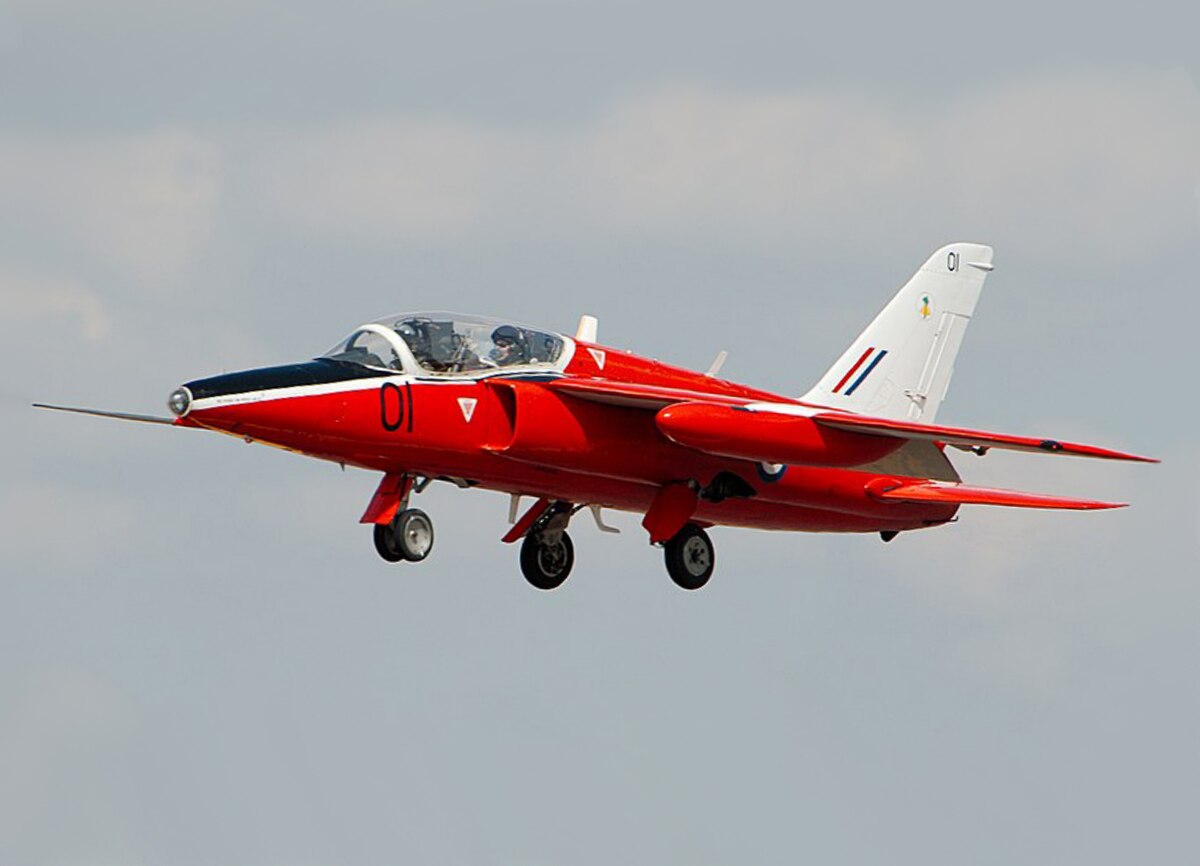
 en.m.wikipedia.org
en.m.wikipedia.org

Please remember Hürjet empty weight 4-5 tons and My offer is 2 ton light attack rapid aircrafts . Especially for MBT hunt. Micro Jet Flies rapidly at low altitude then AESA detects and UMTAS kills.
I want manned light attack jets that max 2 ton weights and max 9 meter long. Speed is very important.
İt should be made from composite materials. Thanks to micro size and composite material the aircraft would have very low RCS so the attack aircraft should fly at very low altitude and at 0.85 mach or mach 1. İt doesn't need long range.
İt would be very cheap elementary first step of jet training. Then the second step will be Hürjets.
Currently just a human brain could infiltrate enemy lines and just a pilot could hunt ground targets at very high speed and low altitude.
The jet should have repositioned Compact AESA radar to detect stationary MBT, IFV, SAM systems artillery etc.. İt and also should carry just long range ATGMs.
The next step will be making this CAS jet unmanned so investment will be saved.
My Candidate platforms are
1)Marchetti s211 and 2)Foland Midge or GNAT
İmagine as if those light attack aircrafts had latest radars Sensors and UMTAS missiles. Then they would be unmanned.

SIAI-Marchetti S.211 - Wikipedia

Folland Gnat - Wikipedia
Please remember Hürjet empty weight 4-5 tons and My offer is 2 ton light attack rapid aircrafts . Especially for MBT hunt. Micro Jet Flies rapidly at low altitude then AESA detects and UMTAS kills.
Last edited:
So, you want to make a MANPADSbait? Why bother with something so convoluted at all when we have Karaok and OMTAS? In fact, OMTAS weighs 35kg or something like that, making a drone that is capable of carrying that would be cheaper, Karaok weighs even less. Why waste hundreds of thousands?So guys i am ready to take punches!
I want manned light attack jets that max 2 ton weights and max 9 meter long. Speed is very important.
İt should be made from composite materials. Thanks to micro size and composite material the aircraft would have very low RCS so the attack aircraft should fly at very low altitude and at 0.85 mach or mach 1. İt doesn't need long range.
İt would be very cheap elementary first step of jet training. Then the second step will be Hürjets.
Currently just a human brain could infiltrate enemy lines and just a pilot could hunt ground targets at very high speed and low altitude.
The jet should have repositioned Compact AESA radar to detect stationary MBT, IFV, SAM systems artillery etc.. İt and also should carry just long range ATGMs.
The next step will be making this CAS jet unmanned so investment will be saved.
View attachment 67714
View attachment 67715
My Candidate platforms are
1)Marchetti s211 and 2)Foland Midge or GNAT
İmagine as if those light attack aircrafts had latest radars Sensors and UMTAS missiles. Then they would be unmanned.

SIAI-Marchetti S.211 - Wikipedia
en.m.wikipedia.org
View attachment 67716
View attachment 67717
Folland Gnat - Wikipedia
en.m.wikipedia.org
Please remember Hürjet empty weight 4-5 tons and My offer is 2 ton light attack rapid aircrafts . Especially for MBT hunt. Micro Jet Flies rapidly at low altitude then AESA detects and UMTAS kills.
Good luck with your slow drones( MANPADSbait ) that would be blocked and jammed over battle in case of EW. Or you wouldn't fight against an Army that had this technology? Would your enemies be just African tribes?So, you want to make a MANPADSbait? Why bother with something so convoluted at all when we have Karaok and OMTAS? In fact, OMTAS weighs 35kg or something like that, making a drone that is capable of carrying that would be cheaper, Karaok weighs even less. Why waste hundreds of thousands?
Vice versa i offered relatively cheaper and ground attack aircraft rather than Hürjet.
According to you Hürkuş -C should be BS.
Last edited:







